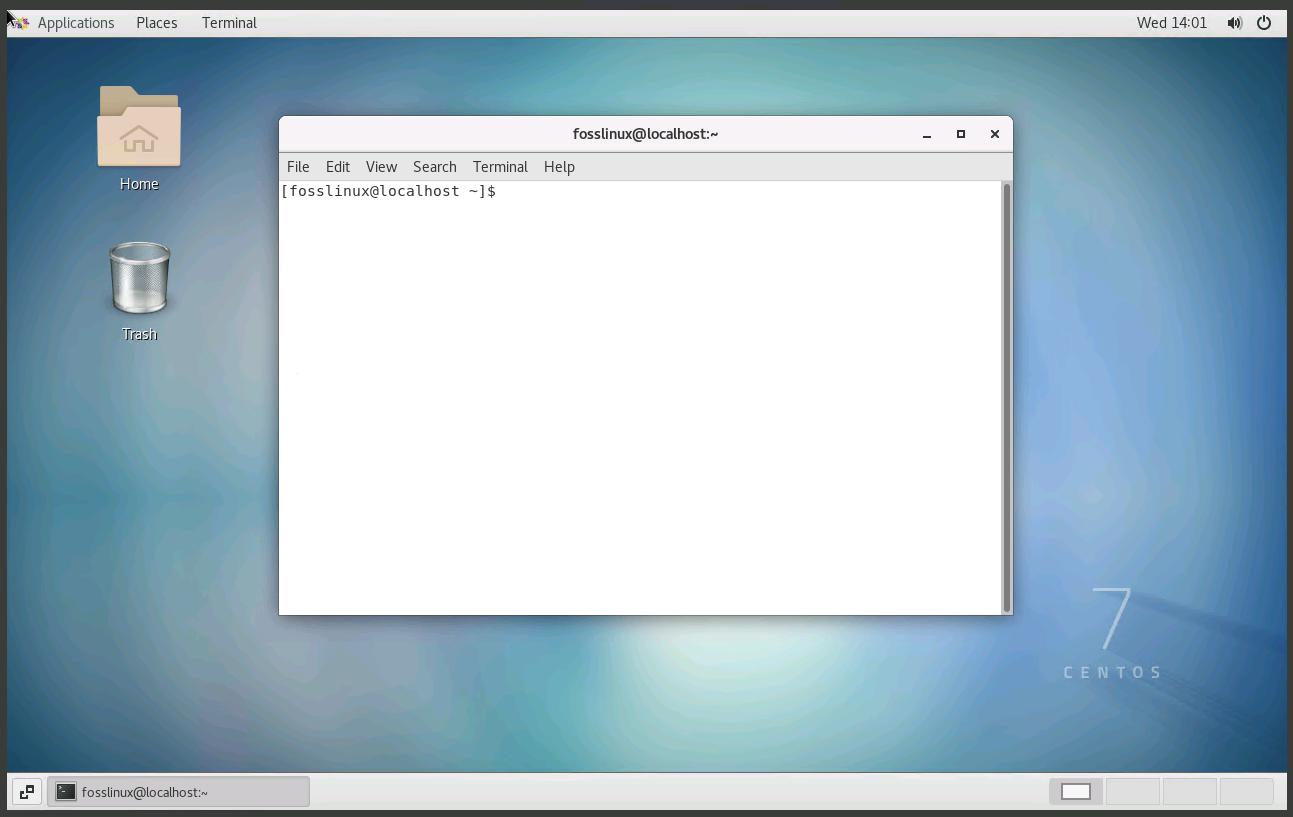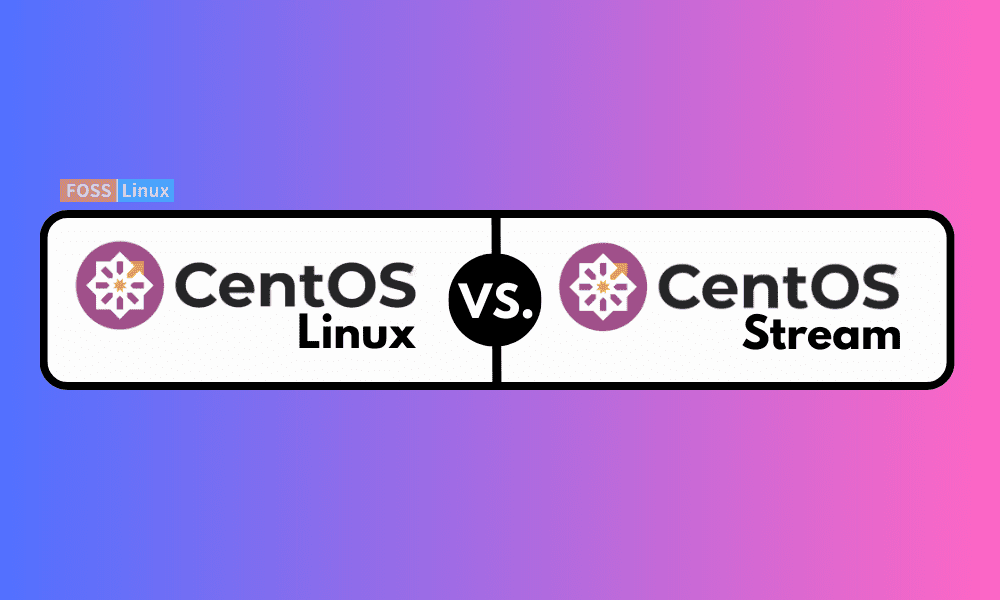We are going to take you on a journey into the heart of one of the most popular and well-respected Linux distributions – CentOS. Specifically, we will draw a detailed comparison between CentOS Stream and CentOS Linux, shedding light on their functionalities, distinct features, as well as their pros and cons.
An introduction to CentOS Linux

CentOS Linux 7 Desktop
CentOS Linux is a free and open-source, community-supported computing platform that derives its roots from the sources of Red Hat Enterprise Linux (RHEL). It offers a stable, secure, and high-performance execution environment for a variety of applications, such as servers, desktops, and cloud infrastructures.
One of the aspects I love about CentOS Linux is its robust stability. It’s designed for those who prioritize a rock-solid system over the latest features. CentOS Linux, however, was put to an end in 2021, with CentOS 8 being the last of its kind.
Wait, but there is still CentOS Linux 7 available to download?
You are correct. CentOS Linux 7 is still available and is supported until June 30, 2024. However, CentOS Linux 8 was discontinued in December 2020, and there will be no CentOS Linux 9.
However, the CentOS Project also recognized that there was still demand for a stable and reliable Linux distribution. Therefore, the CentOS Project decided to keep CentOS Linux 7 available until June 30, 2024.
So, if you are looking for a stable and reliable Linux distribution, CentOS Linux 7 is still a good option for now. However, if you are looking for a distribution that is always up-to-date with the latest features and updates, then CentOS Stream is a good option. We will talk about that next.
An introduction to CentOS Stream

CentOS Stream 9 Desktop
On the other hand, CentOS Stream serves as a rolling-release distro, which means it continuously provides updates. This characteristic offers developers an excellent opportunity to view the development process in real-time, thus serving as a preview version of RHEL.
Personally, I found CentOS Stream to be more forward-leaning and innovative in nature compared to its stable counterpart. It allows you to keep pace with the newest enhancements, which, in my opinion, is a considerable advantage for developers and early adopters.
I have personally used both CentOS Stream and CentOS Linux extensively, and while I appreciate each for its unique strengths, I do have my preferences, which I will share with you all in due course. Let’s dive right in, shall we?
Development and Ownership of CentOS Linux and CentOS Stream
Let’s dive a little deeper into the creators and custodians of CentOS Linux and CentOS Stream.
CentOS Linux and CentOS Stream, both are products of the same development team. The project was initially founded by a group of Linux enthusiasts and later, it caught the attention of Red Hat. The CentOS project officially joined Red Hat in the year 2014, contributing to the open-source ecosystem while maintaining its own independent community.
When CentOS was first released, it was not owned or controlled by Red Hat. However, Red Hat was always a significant influence given that CentOS is a downstream version of Red Hat’s RHEL. The voluntary and community-driven nature of CentOS gave it the flexibility to be independent.
After the CentOS project joined Red Hat, CentOS Linux continued to be a downstream version of RHEL, meaning it was built from the RHEL source code and released after RHEL. On the other hand, CentOS Stream positioned itself between Fedora and RHEL in the Linux distribution spectrum. It acts as an upstream (development) branch for RHEL.
In December 2020, Red Hat announced a shift in focus towards CentOS Stream. This marked the end of CentOS Linux, with CentOS 8 being its last release. The move was intended to help align CentOS and Fedora more closely with RHEL, to provide a more coherent and streamlined development and testing process. Red Hat now owns and oversees the development of CentOS Stream.
While this move stirred some controversy among users who relied on the stability of CentOS Linux, it’s worth noting that Red Hat has committed to providing resources and support to help CentOS Stream succeed.
Thus, both CentOS Linux and CentOS Stream were developed by the same team and are now owned and managed by Red Hat. Their unique positioning in the RHEL development ecosystem serves different user needs and offers varying levels of stability and access to the latest software advancements. As always, the choice between the two will depend on your specific requirements and the trade-offs you are willing to make.
The rationale behind the shift from CentOS Linux to CentOS Stream
There’s been a lot of curiosity and speculation about the decision to phase out CentOS Linux and focus on CentOS Stream. To get a deeper understanding of this shift, we need to delve into the intricacies of Linux distribution development.
CentOS Linux was a downstream build of RHEL, meaning it incorporated changes and updates after they were implemented in RHEL. This made CentOS Linux extremely stable and reliable, but it also meant it lagged behind RHEL in terms of new features and updates. For users seeking stability, especially in server environments, this was a beneficial trade-off. But for those who wanted the latest features, it was a limitation.
CentOS Stream, in contrast, is an upstream (development) branch of RHEL, meaning that changes and updates are integrated into CentOS Stream before they are implemented in RHEL. This allows developers and users to see upcoming changes to RHEL in advance and gives them the opportunity to contribute to these changes. The shift towards CentOS Stream can be seen as a move towards a more proactive, forward-looking approach to development.
Moreover, this shift helps Red Hat align its resources better. By focusing on CentOS Stream, Red Hat can streamline its development process, avoid duplicating work, and deliver updates and features more quickly. It creates an environment that encourages open collaboration, which, in the long run, can lead to more innovative and stable software.
However, this move was not without controversy. Many users who had relied on the stability of CentOS Linux were concerned about the impact of this change. To address these concerns, Red Hat has committed to supporting CentOS Stream and has launched a new offering called “RHEL for Open Source Infrastructure” to provide more options for users.
In essence, the decision to phase out CentOS Linux and focus on CentOS Stream is a strategic move by Red Hat to streamline its development process and foster innovation. While it may cause some short-term disruption, the hope is that in the long term, it will lead to a stronger, more dynamic open-source ecosystem.
CentOS Stream vs. CentOS Linux
1. Comparing the update process
In CentOS Linux, updates are infrequent and often incorporate only critical fixes or security patches. This aspect ensures the system’s utmost stability but may lag in terms of the latest features. For a server environment, I always found this attribute of CentOS Linux particularly reassuring, knowing that the odds of system breakdown due to an update are minimal. Note that this was when CentOS 7 was being actively developed. With the build’s end-of-date appearing soon, updates have also ceased.
However, CentOS Stream provides regular updates, offering users the most recent software and features. Being a rolling-release distro, it can be a double-edged sword – it’s up-to-date, but it may introduce potential instability. It’s exciting for those who prefer being on the cutting edge, although it might require more attention to avoid any pitfalls.
2. Understanding the release model
CentOS Linux follows the point-release system, wherein major updates are bundled into versions released at specific intervals. I have always appreciated this approach as it offers a comprehensive update, leaving little room for inconsistencies. Plus, it means less frequent reboots for servers, which is a big plus for admins like me.
On the other hand, CentOS Stream is a rolling-release distro, implying that updates are released as and when they are ready. This makes CentOS Stream an attractive option for those who value constant improvement and innovation, despite the possible challenges with stability.
3. A look at the support
The CentOS Linux community support has always been tremendous. The community forums and mailing lists are places of active interaction, and whenever I ran into an issue, I found answers there quite easily.
CentOS Stream also has an active community, but being the newer entrant, it might take some time to match the depth and breadth of support seen in CentOS Linux. However, being directly under Red Hat’s umbrella, it should provide a level of reassurance for professional users.
Comparison Summary
| CentOS Linux | CentOS Stream |
|---|---|
| Traditional release cycle, aimed at stable production environments. | Rolling-release model, acting as the upstream development branch for RHEL. |
| Receives updates until the end of its lifecycle. | Continuously receives updates, including features that will be in the next RHEL release. |
| Highly stable, updates mainly for security and bug fixes. | Less stable, includes pre-release features and updates. |
| Targeted at users prioritizing stability over latest features. | Aimed at developers and users wanting early access to future RHEL features. |
| Fixed lifecycle, usually 10 years, with a clear end-of-life date. | Evolves continuously, without a traditional end-of-life. |
| Ideal for production servers where stability and long-term support are crucial. | Suitable for developers, testers, and early adopters. |
| Uses version numbers (e.g., CentOS 7, CentOS 8). | Follows RHEL development, with stream indicating ongoing updates. |
| Highly compatible with corresponding RHEL release, offering a free alternative without the subscription. | Offers a preview of future RHEL versions, with slight package differences due to its rolling nature. |
Final thoughts
As we’ve discussed in detail, both CentOS Linux and CentOS Stream serve different needs and priorities. CentOS Linux, with its high stability and robustness, has long been a go-to choice for servers and environments where predictability is vital. However, CentOS 8, the last release of CentOS Linux, reached its end of life at the end of 2021.
Yet, if you are currently using CentOS Linux 7, you can still benefit from its stable environment until June 30, 2024. It’s worth noting this date, as after this, CentOS Linux 7 will no longer receive updates or security patches. As such, planning your migration strategy in advance can help ensure a smooth transition.
Meanwhile, CentOS Stream carves out its niche, being a rolling-release distro that offers the latest features and updates, providing a unique peek into the future developments of RHEL. For users who appreciate constant innovation and want to contribute to the future of RHEL, CentOS Stream can be an exciting option.
The shift from CentOS Linux to CentOS Stream was a strategic decision by Red Hat to foster open-source development, streamline processes, and quicken the pace of innovation. While it introduced a transition phase for many users, it also presented opportunities for growth and advancement in the open-source ecosystem.


1 comment
why width is locked on mobile view? Comparision Summary has hidden third column with centos stream.. it is only visible in desktop mode